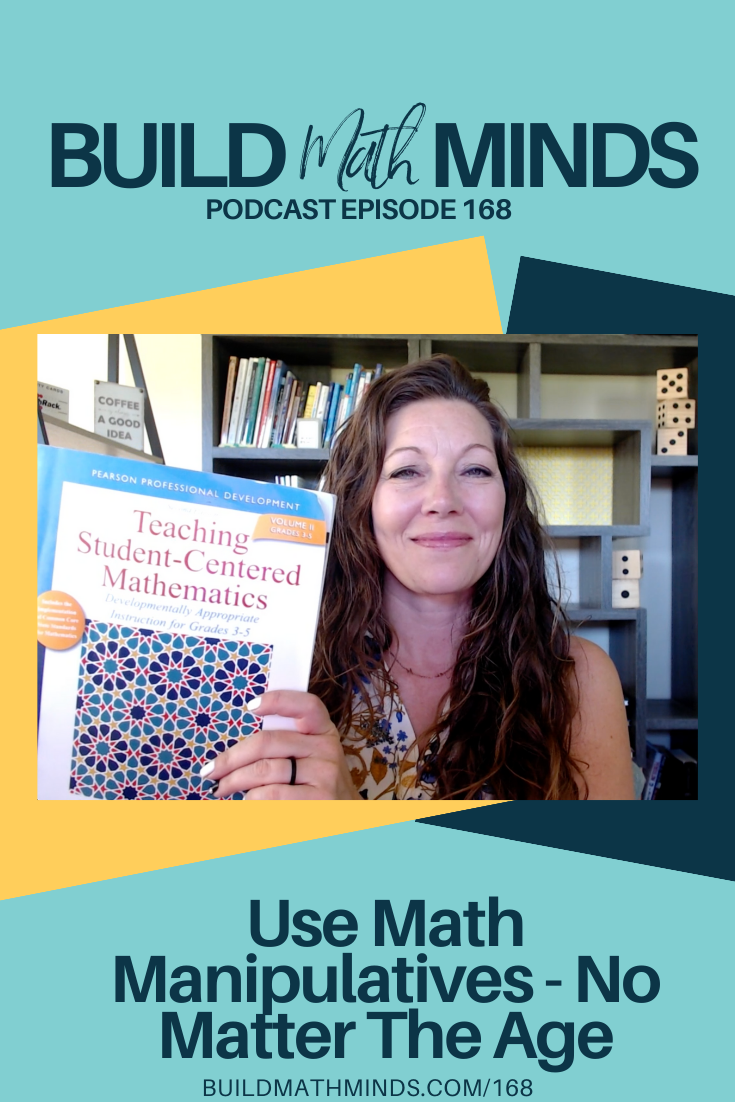Join the Waitlist for K-2 Flexibility Formula Course or the 3rd-5th Flexibility Formula Course
Teaching Student-Centered Mathematics series by John Van de Walle, LouAnn Lovin, Karen Karp, and Jennifer Bay-Williams (there are books for PreK-2, 3-5, and 6-8)
The youtube video for this episode
Welcome fellow Recovering Traditionalists to Episode 168: Use Math Manipulatives – No Matter The Age.
Before we get into the episode, this week’s positivity comes from an end of course paper that was turned in when this participant finished my online course for teachers, The Flexibility Formula. There was so much in this paper that I just loved reading and even made me tear up:
Before we get into the episode, this week’s positivity comes from a paper sent in by a participant in one of my Flexibility Formula courses:

That last part got me. I remember when I started learning more about how children actually learn math (compared to how I was teaching it) and I felt horrible for my former students. I was doing my best but I just didn’t know how to help them. If you are looking to learn more about how students develop their number sense and fluency with operations, I’ll be opening up registration to The Flexibility Formula soon. We have some special gifts to people who enroll early but the only way to get the link to enroll early is to be on the waitlist for the courses. You can go to BuildMathMinds.com/courses then click on the link of the course you are interested in to learn more and join the waitlist or go to the show notes page for this episode and I’ll have each course (the K-2 and the 3-5) linked up for you.
Those special gifts you can get if you enroll early are some of my favorite manipulatives, the rekenrek for K-2 and Blank Fraction Tiles for 3-5. I’m a huge fan of using manipulatives no matter what grade level. I wasn’t always that way. As you all know I’m a Recovering Traditionalist so I used to be the traditional type of teacher where I just had students learn the procedures and then practice them over and over.
One of the books I credit for changing my thinking is actually a series of books. Teaching Student-Centered Mathematics by John Van de Walle and Friends is a must-have for any math educator. We are going to take a look at the 3rd-5th grade book today, but this information is also in the PreK-2 and the 6-8th grade books.
On page 23 they show this graphic that depicts the different ways to demonstrate mathematical understanding and I also think these ways also help BUILD mathematical understanding. In the video for this episode, you can see the visual (remember that is at YouTube.com/BuildMathMinds) but basically the ways are to Give a Context, Explain Meaning in Words, Illustrate with Physical Tools (manipulatives), Write Using Symbols, Draw a Diagram, Display Data in a Table, Create a Graph. The last two are only applicable to specific types of math situations but the first 4 should be done all the time. However, typically the use of manipulatives starts to diminish as kids get older and we start to increase the use of just the writing of symbols. Kids need all 4 of these no matter their age.
On page 24-25 they write:
“Let’s turn to one kind of representation that is commonly used to support students’ learning of mathematics – manipulatives or concrete objects. Any time a concept is new, regardless of the ages of the students, manipulatives can help make the concept visual, concrete, and connected to other ideas students have learned. Used wisely, they can be a positive factor in students’ learning. Only using manipulatives, however, particularly in a rote manner, does not ensure that students will understand. It is important to consider how manipulatives can help, or fail to help, students construct mathematical knowledge.
First of all, manipulatives alone have no inherent meaning. A person has to impose meaning on them. The manipulative is not the concept….
…Second, the most widespread misuse of manipulatives occurs when teachers tell students, “Do exactly as I do.” There is a natural temptation to get out the materials and show students exactly how to use them. Students mimic the teacher’s directions, and it may even look as if they understand, but they could be just following what they see. A rote procedure with a manipulative is still just that – a rote procedure.
A third and related misuse of manipulatives occurs when teachers always tells students which manipulatives to use for a given problem. Students need opportunities to choose their own representations to use when reasoning through a problem (Mathematical Practice 5, ‘Use appropriate tools strategically’) and when communicating their ideas to others.”
So, no matter the grade level let your students use manipulatives without it being seen as the math concept (for example, using a rekenrek is not a strategy to practice…it’s just a tool kids use to model their thinking) and without us telling them specifically HOW and WHEN to them. Manipulatives should be always available and kids should know they can use them how they’d like and when they’d like.
Until next week my Fellow Recovering Traditionalists, keep Building Math Minds.




